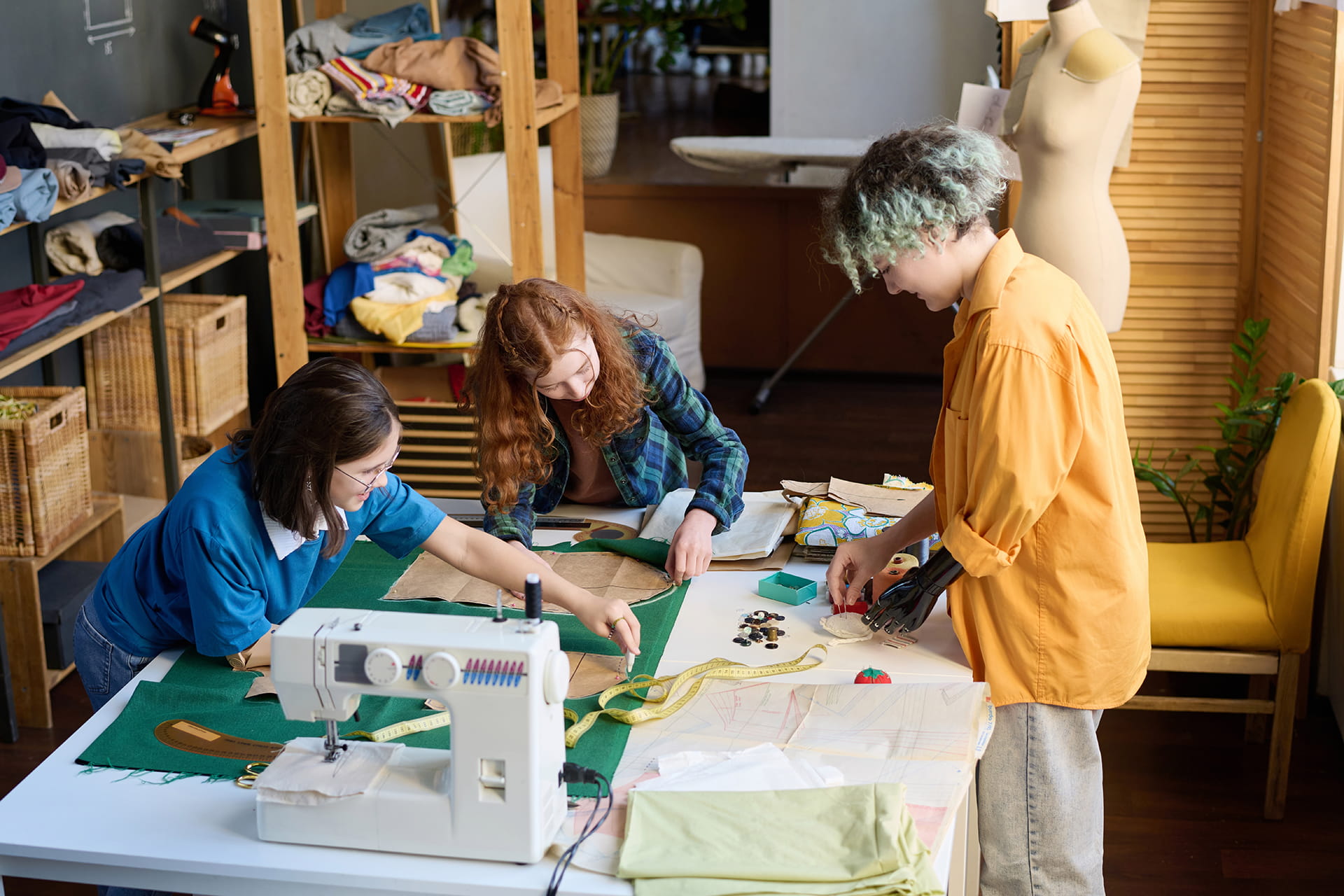When asked about their attitudes towards ecology and sustainable consumption, Poles usually declare that they are conscious and responsible consumers. Those who take part in surveys on the subject claim that they are concerned about the environment and are aware of the impact of their own behaviour on its condition (p. e.g. CBOS; 2020; Ekobarometr, 2024). However, these pro-environmental declarations do not always translate into actual behaviour – we waste a lot of food, often use plastic shopping bags and prefer to drive rather than use public transport (Eurostat, 2022; Biostat, 2019). LPP’s Wear Your Story campaign report (February 2024), dedicated to the repair and reuse of clothing, shows that many consumers are aware of the negative consequences of throwing away clothes and that by reducing their purchases they are acting in favour of the environment. However, the respondents also admit that they rarely (or not at all) repair damaged items of clothing, and when asked what they would do if the cost of repairing old trousers was equal to the price of new ones, they say they would rather buy new ones.
This so-called attitude-behaviour gap (the discrepancy between declaration and action) has long been the subject of many studies whose authors attempt to understand its causes (Stasiuk, Maison, 2014; Stasiuk, Tischner, 2024). In the case of clothing consumption the cause might be objective obstacles, such as lack of skills, time or equipment (e.g. a sewing machine) needed to repair it (LPP, 2024). However, barriers related to psychological factors – boredom with the clothes one owns, the pleasure of shopping, and the associations that the activity of mending clothes itself may evoke – seem to be more important.
Today’s consumers get bored easily, which can be observed even in young children who stop enjoying a new toy shortly after receiving it. Boredom is a consequence of what is known as the “hedonic decline” – a situation in which repeated exposure to an initially pleasurable stimulus (such as a new toy or item of clothing) leads to habituation and a decrease in positive emotions. This is particularly the case when other new and interesting stimuli are available (Galak, Redden, 2017; Kwon, 2019).
For consumers, this incentive is the huge number of products offered in shops, especially those related to fashion. Recently bought clothes quickly become boring and are perceived as “old”, even if they do not show signs of wear or look damaged. They are “old” because they have been worn a few or a dozen times, and shops are full of clothes whose main advantage is that they are new.
The barrier to fixing clothes is not only the boredom with the clothes one owns and the pleasure that new things give (for a short time), but also the feeling of satisfaction associated with the shopping activity itself. It stimulates the brain’s reward system – the structures in the brain that release dopamine, the so-called happiness hormone (Voon et al, 2010).
Walking around stores and selecting products provides consumers with instant gratification in the form of positive emotions, so they treat shopping as an excellent leisure activity. For many people, shopping can also be more than just entertainment – they use it as a strategy to regulate negative emotions and reduce stress (so-called “shopping therapy”; Kim, Chang, 2023). With such an emotional gain from shopping, the negative environmental consequences seem distant and abstract, and rational arguments about the environmental benefits of extending the life of clothing may not be very persuasive.

Many people wearing repaired clothes can also be seen as a symbol of the past, of a time when people could not afford to buy new things very often, and what was available in shops was usually dull and unattractive. In those days, sewing and mending was a necessity (for financial reasons), but also a way of expressing individuality. Today, repairing clothes is no longer a necessity, but rather a choice that consumers do not make very often. In the LPP study (2024), more than half of the respondents admitted that when they notice damage to a garment, they usually throw it away and replace it with a new one, and that they consider repair skills, although necessary, to be “a thing of the past”.
The barriers described above may raise doubts as to whether it is possible to convince consumers to use tailors more often or to repair clothes themselves. In my opinion, it is because, despite these barriers, consumers see the positive value of extending the life of clothes. However, it is not a “cognitively accessible option” for them – although they know it is a possibility, they quite rarely consider it.
One way of re-establishing repairing clothes as an accessible and attractive option may be to refer to social norms, i.e. customs and rules of behaviour accepted in a given society. Research on the influence of norms on behaviour is mainly conducted by psychologists, who divide them into two types: descriptive and injunctive (Wojciszke, 2011). Descriptive norms are about how most people act in a given situation, and their motivating effect on behaviour can be rooted in providing evidence that the most common course of action is effective and beneficial (‘since many people behave a certain way, it must be right’). Injunctive norms, on the other hand, tell a person what to do in a given situation, and their motivational effect on behaviour may be rooted in the approval (or lack of approval) from others (Wojciszke, 2011). In the case of mending clothes, norms can be created by showing consumers (e.g. through media campaigns or social media) that this is an activity that is not “a thing of a past” after all, and that wearing mended clothes is becoming popular and socially approved. Recently, there has been a growing number of initiatives promoting responsible fashion. These include not only media campaigns, but also repair cafes or workshops for repairing and upcycling clothes, which are growing in popularity (Medium, 2023, Vogue, 2020). This shows that while a sustainable approach to fashion is not a widespread trend, a change in mindset and behaviour (at least among some consumers) is possible.

Author: Dr hab. Katarzyna Stasiuk, prof. UJ
Literature:
Biostat (2019). Transportowe zwyczaje Polaków. https://www.transport-publiczny.pl/wiadomosci/polacy-lubia-transport-publiczny-ale-kochaja-auta-badanie-60862.html
CBOS (2021). Polacy i rzeczy używane. https://www.cbos.pl/SPISKOM.POL/2021/K_092_21.PDF
Ekobarometr (2024) https://swresearch.pl/oferta/ekobarometr
Eurostat (2022). Consumption of lightweight plastic carrier bags https://ec.europa.eu/eurostat/databrowser/view/ENV_WASPCB__custom_3210848/
Galak, J., & Redden, J. P. (2018). The properties and antecedents of hedonic decline. Annual review of psychology, 69(1), 1-25.
Kim, S., & Chang, H. J. J. (2023). Mechanism of retail therapy during stressful life events: The psychological compensation of revenge consumption toward luxury brands. Journal of Retailing and Consumer Services, 75, 103508.
LPP (2024) Naprawa i przerabianie ubrań. https://dbajoubranie.pl/raport-naprawiaj-przerabiaj-odziez/
Medium (2023) The Rise of Repair Cafes and Their Role in IT Sustainability.
https://itrecycle2020.medium.com/the-rise-of-repair-cafes-and-their-role-in-it-sustainability-9d4cb5c5d775
Stasiuk, K., Maison, D. (2014). Psychologia konsumenta. Warszawa: PWN
Stasiuk, K., Tischner, A. (2024). Refurbishing – polscy konsumenci wobec praktyki odnawiania produktów. Artykuł w recenzjach
ThreadUp (2023) Polacy kupują ubrania z drugiej ręki. Second handy coraz popularniejsze. https://300gospodarka.pl/news/polacy-kupuja-ubrania-z-drugiej-reki-co-czwarty-z-nas-wybiera-secondhandy
Wojciszke, B. (2011). Psychologia Społeczna. Warszawa: Scholar
Vogue Business (2020). With Gen Z under lockdown, DIY fashion takes off
https://www.voguebusiness.com/fashion/with-gen-z-under-lockdown-diy-fashion-takes-off
Voon, V., Pessiglione, M., Brezing, C., Gallea, C., Fernandez, H. H., Dolan, R. J., & Hallett, M. (2010). Mechanisms underlying dopamine-mediated reward bias in compulsive behaviors. Neuron, 65, 135-142.
